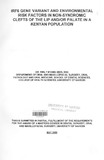| dc.contributor.author | Nyamu, Emily | |
| dc.date.accessioned | 2013-05-24T06:45:10Z | |
| dc.date.available | 2013-05-24T06:45:10Z | |
| dc.date.issued | 2009 | |
| dc.identifier.citation | Masters degree in dental surgery, oral and maxillofacial surgery | en |
| dc.identifier.uri | http://erepository.uonbi.ac.ke:8080/xmlui/handle/11295/25102 | |
| dc.description.abstract | Background: Non-syndromic cleft lip and/or palate are common craniofacial
congenital disorders. Their aetiology is largely unknown but genetic and
environmental factors have been implicated. In this regard, various genes have
been studied as the causative factors. One such gene is the Interferon
Regulatory Factor 6 (IRF6) gene whose mutations have been found to cause the
Van der Woude syndrome, a disorder characterised by lower lip pits with or
without cleft lip/palate. Unlike the other genes that have been studied so far, the
IRF6 gene shows consistency in the association of its mutations to nonsyndromic
cleft lip with or without cleft palate (Cl +/-P) among various
populations. There is a paucity of information regarding the contribution of these
gene variations to non-syndromic Cl +/- P in the indigenous African population.
Objective: To determine the presence of an IRF6 gene variant in non-syndromic
cases of Cl +/- P in an indigenous African population.
Material and Method: A descriptive cross-sectional study was conducted
utilizing a purposive sampling method to select hospitals, in the urban and rural
areas, where the Operation Smile and Smile Train Missions were offering free
treatment for Cl +/- P and cleft palate (CP) patients. Convenient sampling was
used to recruit 113 patients with non-syndromic orofacial clefts with their
accompanying biological parents. DNA was extracted from buccal cell samples
and the presence of an IRF6 gene variant (rs2013162) was determined.
Environmental risk factors were determined from a questionnaire.
Data Analysis: Frequency distributions and proportions were used for the
description of findings. The Chi square with Yates correction and Wilcoxon
Signed Rank's tests were used to determine the relationship between the
variables.
Results: Of the 113 children in the study, 65 were male while 48 were female.
The age of presentation ranged between 1 month and 15 years with a mean of
26 months. Majority of the children (87.6%) were in the 0-5-year age group. At
the birth of a deft afflicted child, most of the mothers (69%) were below the age
of 30 years while most of the fathers (54.9%) were above 30 years of age. The
pattern of defts was 53.1% for CL, 43.4% for CLP and 3.5% for CPo A female
predilection was observed for the CL and CP phenotypes while a male
predilection was noted for the CLP phenotype. The IRF6 gene variant
(rs2013162) was present in 3 of the children and 3 of the mothers studied. Only
one of these mothers transmitted the gene variant to her child. None of these
children was exposed to any of the other risk factors studied. Only 1 mother gave
a history of smoking and 4 of alcohol use during pregnancy. Almost a quarter of
the mothers had used prescription drugs during pregnancy and familial clefts
were reported in 14% of the families.
Conclusion: The IRF6 gene variant was present to a limited extent in the
Kenyan population studied (2.7% of the children and 2.7% of the mothers). This
suggests that perhaps a different IRF6 gene variant or a different gene altogether
may contribute to non-syndromic clefts in the African population studied. It is also
possible that the non-syndromic clefts in the African population have a higher
environmental as opposed to genetic influence in their aetiology. However, a
large population study is recommended to ascertain these implications.
Increasing paternal age and prescription drug history during pregnancy | en |
| dc.description.sponsorship | University of Nairobi | en |
| dc.language.iso | en | en |
| dc.title | Irf6 gene variant and environmental risk factors in non-syndromic clefts of the lip and/or palate in a Kenyan population | en |
| dc.type | Thesis | en |
| dc.description.department | a
Department of Psychiatry, University of Nairobi, ; bDepartment of Mental Health, School of Medicine,
Moi University, Eldoret, Kenya | |
| local.publisher | Department of oral and maxillofacial surgery, oral Pathology and oral medicine, school of dental sciences, College of health sciences, university of Nairobi | en |

